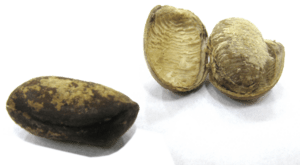Calabash nutmeg facts for kids
Quick facts for kids Calabash nutmeg |
|
|---|---|
 |
|
| Illustration from Curtis's Botanical Magazine, 1831 | |
 |
|
| Monodora myristica seeds | |
| Scientific classification | |
| Genus: |
Monodora
|
| Species: |
myristica
|
| Synonyms | |
|
|
The Monodora myristica, also known as the calabash nutmeg, is a cool tropical tree. It belongs to the Annonaceae family, which is also called the custard apple family. This tree is a type of flowering plant.
You can find the calabash nutmeg growing naturally in many countries in Africa. These include Angola, Benin, Cameroon, the Central African Republic, and the Democratic Republic of the Congo. It also grows in Equatorial Guinea, Gabon, Ghana, Guinea-Bissau, Ivory Coast, Kenya, Liberia, Nigeria, the Republic of the Congo, Sierra Leone, Sudan, Tanzania, Togo, and Uganda.
Long ago, the seeds of this tree were sold widely as a cheaper alternative to regular nutmeg. Today, this is less common, especially outside the areas where it grows. The calabash nutmeg has many other names too. Some people call it Jamaican nutmeg, African nutmeg, ehuru, ariwo, awerewa, ehiri, airama, African orchid nutmeg, muscadier de Calabash, or lubushi.
Contents
Where Does Calabash Nutmeg Grow?
The calabash nutmeg tree naturally grows in evergreen forests. You can find it from Liberia all the way to Nigeria and Cameroon. It also thrives in Ghana, Angola, and even in Uganda and western Kenya.
During the 1700s, this tree was brought to the Caribbean islands. This happened because of the slave trade. Once there, it became well-known as Jamaican nutmeg. In 1897, Monodora myristica was introduced to the Bogor Botanical Gardens in Indonesia. The trees there flower regularly, but they haven't produced fruit yet. Because its flowers are large and look like orchids, people also grow this tree just for its beauty.
What Does the Tree Look Like?
Tree and Leaves
The Monodora myristica tree can grow very tall, reaching up to 35 meters (about 115 feet). Its trunk can be as wide as 2 meters (about 6.5 feet) across at chest height. It has a clear main trunk and its branches spread out horizontally.
The leaves grow one after another along the stem. They hang downwards and are shaped like an oval or are widest near the tip, then get narrower towards the stem. Each leaf has a small stalk called a petiole. These leaves can grow quite large, up to 45 cm (about 18 inches) long and 20 cm (about 8 inches) wide.
The Flower
The flowers of the calabash nutmeg appear at the base of new shoots (new growth). Each flower grows alone and hangs down. They are large and smell very nice. The flower stalk, called a pedicel, can be up to 20 cm (about 8 inches) long. It also has a small, leaf-like part called a bract.
The flower's sepals (the leaf-like parts that protect the bud) are spotted with red, crinkled, and about 2.5 cm (1 inch) long. The corolla (the petals of the flower) has six petals. The three outer petals can be up to 10 cm (4 inches) long. They have curled edges and are spotted with red, green, and yellow. The three inner petals are almost shaped like triangles. They form a cone that is white and yellowish. On the outside, this cone is spotted with red, and on the inside, it is green.
The flower's stigma (the part that receives pollen) becomes ready before its stamens (the parts that produce pollen) are fully grown and release their pollen. This means the flower is pollinated by insects.
Fruit and Seeds
The fruit of the calabash nutmeg is a type of berry. It is smooth, green, and round, growing up to 20 cm (about 8 inches) wide. As it ripens, it becomes woody. The fruit hangs from a long stalk that can be up to 60 cm (about 2 feet) long.
Inside the fruit, there are many seeds. These seeds are oblong (like a stretched oval), pale brown, and about 1.5 cm (half an inch) long. They are surrounded by a whitish, fragrant pulp. The seeds contain a clear essential oil, which makes up about 5-9% of their weight.
How People Use Calabash Nutmeg
Fruit and Seeds
The seeds of Monodora myristica smell and taste a lot like regular nutmeg. Because of this, they are a very popular spice in West African cooking. People collect the fruits from wild trees. Then, they dry the seeds and sell them whole or ground up. These seeds are used in many dishes, such as stews, soups, cakes, and desserts.
Besides cooking, the seeds are also used for traditional medicine. They can be used as stimulants, to help with stomach problems, headaches, and sores. They are also used as an insect repellent. Sometimes, the seeds are even made into necklaces.
Timber and Bark
The wood from the Monodora myristica tree is hard but easy to work with. It is used for making furniture (carpentry), parts of houses, and for joining wood together. In traditional medicine, the bark of the tree is used to treat stomach-aches, fevers, eye problems, and haemorrhoids.
Chemical Compounds
The essential oil found in the leaves of the tree contains special compounds like β-caryophyllene, α-humulene, and α-pinene. The main compounds found in the essential oil from the seeds are α-phellandrene, α-pinene, myrcene, limonene, and pinene. These compounds give the seeds their unique smell and taste.
See also
 In Spanish: Moscadero de África para niños
In Spanish: Moscadero de África para niños

